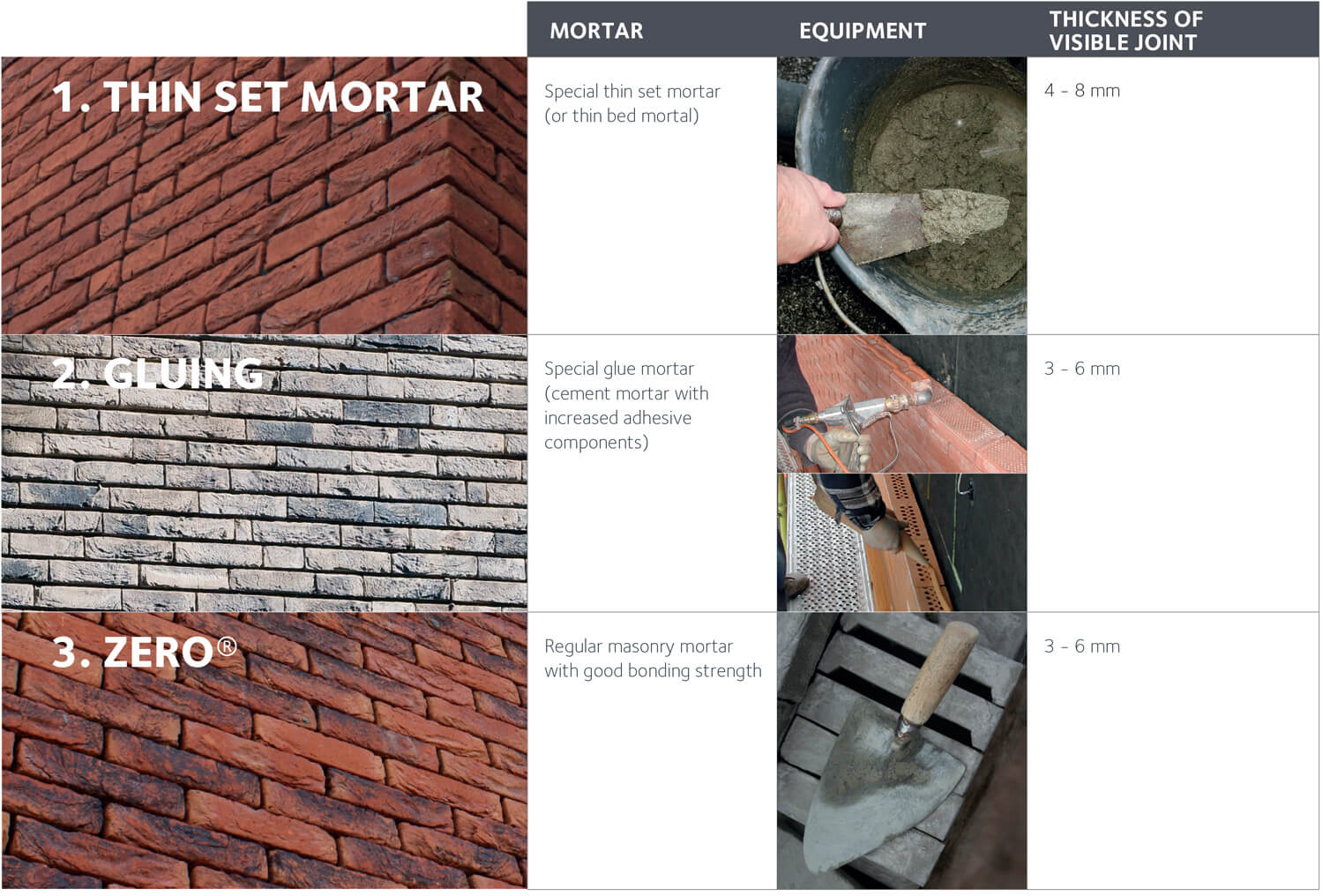No joints
When you choose the purely brick effect the joint is a disrupting factor. Increasingly more contractors choose to create a facade without joints.
There are 3 known methods for creating a masonry without joints:
1. Bricklaying with thin set mortar
2. Gluing together
3. Traditional masonry with ZERO®
Each method generates additional costs compared to classic masonry. More facing bricks are needed per square meter of masonry. And in all cases more care and expertise is expected from the contractor. However, you do get rid of the costs of jointing.
1. BRICKLAYING WITH THIN SET MORTAR
Thin set mortar, a.k.a. thin bed mortar, is a cement mortar to which glue has been added. This increases the adhesive power of the mortar, which is why the thickness of the joint can be reduced to 4 - 8 mm. The mortar is applied in a raked manner and is not jointed.
Advantage
This technique is interesting to use with facing bricks with an irregular design. After all, the mason has enough play to take care of the irregular shapes. The advantage of thin set mortar is that it is not much more expensive than regular cement mortar and that it can be handled with a trowel.
Disadvantage
The disadvantage is mostly aesthetic. Though the joint thickness is reduced, it is nevertheless present. Especially when the joint thickness leans towards 8 mm, is seems sometimes that there is a need for jointing.
2. GLUING
Here a glue mortar is used. The term is somewhat misleading, because this does concern a cement mortar. More lime is added to this mortar, which increases the strength of the mortar considerably. The joint thickness is therefore only 3 to 6 mm, depending on the dimensional stability of the facing brick. Applying the glue mortar with the classic trowel is not self-evident. It sticks too much for this.
The contractor can choose between 2 working methods:
1. With a gluing machine
The glue is applied to the bricks in the form of a sausage by means of a pump and a pistol. A second person lays the next course of bricks, etc. In good conditions this is a very proper and efficient way of working. In case of long breaks (rain, other assignments, etc.) it is necessary to refine the left over mortar in the mixer and to fill the mixer with water. In case of changeable weather this is not always fun and much time is lost. In order to work comfortably you also need more space: the gluing machine takes up a lot of space. This method is often used for bigger projects or when gluing interior blocks.
2. With a spraying sack
Like when applying whipped cream to a cake, with this method the glue mortar is poured into a spraying sack. The glue is then applied to the course of bricks in the form of a sausage. The dosing is adjusted to the desired joint thickness by adjusting the nozzle. The bricks are pressed in the glue. This method requires a bit more arm strength, but saves on the renting costs of a gluing machine. This can be a determining factor in small or medium-sized projects.
Advantage
A glue mortar is more expensive than a thin set mortar, but creates thinner joints. This method really is masonry without joints.
Because the mortar is stronger there are more construction possibilities: for example larger facade openings or spans. This is because the weaker link of facade masonry, the cement mortar, is replaced by a much stronger material.
Disadvantage
Gluing is more expensive due to the higher price of the mortar and the larger number of required facing bricks. Contractors also often charge more for carrying out this kind of work.
Tip
Although the glue mortar is concaved and is hardly visible when applied correctly, it is recommended to adapt the colour to the facing brick. Applying a light grey glue mortar to a dark facade is not a good idea.
3.TRADITIONAL MASONRY WITH ZERO®
ZERO®, an invention of Vandersanden Group, combines modern architecture without joints with the traditional masonry.
Customers and architects often abandon their initial idea of masonry construction without joints because of the higher price or the difficulty to find a contractor who glues for a reasonable price. ZERO® is an ingenious solution due to its simplicity In principle it is nothing more than a specific size facing brick with which you work in the classic manner with mortar and a trowel. And yet, the result is a facade with thin joints of 3 to 6 mm.
The difference between ZERO® and classic masonry is in the laying of the brick. The brick is no longer pressed vertically, but tilted.
ZERO® has a special opening on the upper side of the brick. As a result the mortar bed is lower. It will sink even deeper when the next course of bricks is laid. On the facing side this creates a thinner joint. In addition, we also paid attention to a good proportion between the length and width of the brick so that it is perfect for working with a stretcher bond. This way the work proceeds quickly.
Advantage
For a contractor this way of working is hardly an obstacle. He can work with the material/equipment that is familiar to him.
















